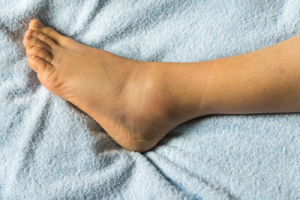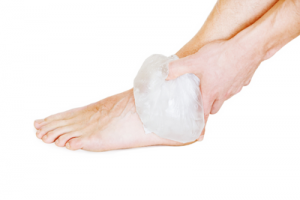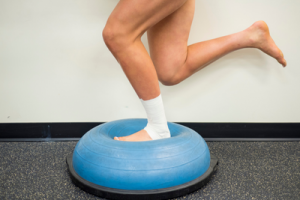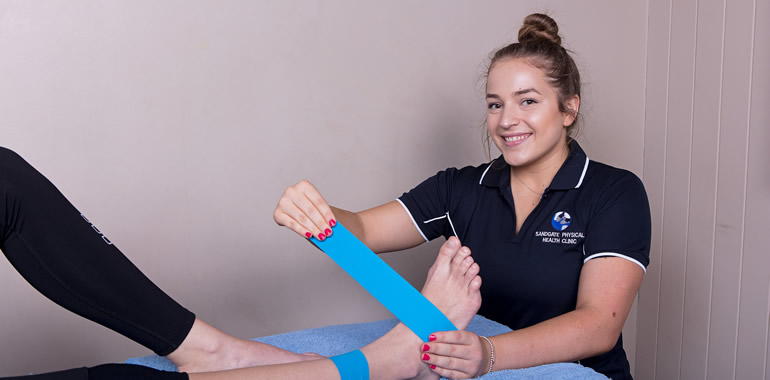Ankle sprains are one of the most common sports injuries in Australia.
Sometimes, all it takes is a sudden jolt or twist to overstretch and tear the supporting ligaments of the joint. This will result in varying degrees of pain, swelling and bruising.
Often the injury will need to be assessed to ensure a break hasn’t occurred, however treatment is generally managed at home with rest and ice. Professional treatment is then recommended so that an exercise program can be created and managed to increase strength and mobility.
What is an Ankle Sprain?

The ankle joint has four bones that interlock to give stability and strong connective tissues called ligaments to prevent too much movement of the joint.
A sudden movement or twist can overstretch these supporting ankle ligaments, usually when the foot rolls in. This causes ligament tears and bleeding at the joint.
This is a very common injury in sports where there is a lot of running, jumping or change of direction, like netball, basketball or football.
Common Symptoms
Symptoms of an ankle sprain include swelling (this can be immediate or take several hours), pain at the ankle joint when trying to move or when walking, and then the subsequent bruising.
Initial Treatment of an Ankle Sprain
Immediate treatment options for a suspected sprained ankle includes the RICE method and includes the following –

- Cease activity
- Rest joint
- Apply ice packs every two hours for 15 minutes at a time
- Apply a firm compression bandage the area, generally extending up the calf and down the foot
- Elevate above heart height if possible
- Avoid further exercise, heat, massage or alcohol in the next 48hrs as this can increase swelling
Seek an assessment from a Physiotherapist as soon as possible. If indicated, your physiotherapist can organise an X-RAY to rule out any fractures, especially if you are unable to put any weight on your foot or take a minimum of 4 steps.
Recurrent Ankle Sprains
Unfortunately, some people have recurring ankle sprains that can be caused by –
- Ligament scarring or excess looseness from previous sprain
- Insufficient treatment or rehabilitation from previous sprain. This causes weakened peroneal or surrounding muscles of the ankle and can also impede your ability to judge where your foot is in relation to your leg (proprioceptive deficit).
Professional Treatment for Rehabilitation and Support
After an ankle sprain it is highly recommended to consult a Physiotherapist for an assessment and treatment plan. There is strong evidence that starting a rehabilitative exercise program in the first week improves ankle function and an earlier return to regular activities.

Treatment may include –
- Exercise program to improve mobility of the joint
- Exercises to strengthen surrounding muscles
- Advice on strapping or braces
- The use of a trampoline, wobble board or other equipment that will improve balance and the proprioceptive deficit.
Prevention Methods to avoid Ankle Sprains in Future
In order to prevent Ankle sprains in future, please include these simple steps in your routine –
- Warm up prior to a game/exercise with sport specific movements
- Wear supportive footwear designed for your sport
- Wear and ankle brace or tape as directed by your Physio
- Take extra consideration of your environment, such as wet or uneven surfaces
How to Strap a Sprained Ankle
Ankle strapping, wrapping or taping, is a very common treatment by physiotherapists to assist a sprained ankle to heal faster and prevent further injury. It limits the range of motion without completely immobilising the ankle. It ensures the ligaments move within limits below the pain level and encourages a faster recovery. When compared to ankle support sleeves or braces, strapping allows for greater flexibility.
The first time you get an ankle injury, a Physiotherapist will assess the severity and often do the initial taping, then provide advice on how to tape yourself (for less serious sprains).
The technique of strapping will depend on the type of sprain.
- Inversion sprains – the foot will turn inwards due to a sprain in the lateral (outside) ligament. This is the most common type of sprain.
- Eversion sprains – tear the medial (inside) ligament, causing the foot to evert in the other direction.
An inverted sprain will be wrapped starting from the inside, sticking the tape towards the outer foot, whilst an everted sprain should be taped from the opposite side.
Here an Ankle Strapping Video and some tips we like to follow when taping an inversion sprain –
Ankle Strapping Instructions
- Foot is to be clean or use a specialised kinesio pre-tape spray.
- Put the foot in dorsiflexion, facing the shin upwards at a 90-degree angle, and maintain that position while the taping is in progress..
- Create anchors by circling the sports tape around lower leg above the ankle joint.
- Secure the foot with stirrups. Starting from the inside of the leg, tape the foot by adding a layer from the inner anchor, below the foot, and to the outside anchor. Repeat three times.
- Place three to 6s and reverse 6s. These alternate starting at the inside and outside of the leg but travel across the front of the ankle before going under the foot and coming back up to join at the starting point.
- Use figure-eight strapping to surround the ankle area from all sides by angling the tape following the natural foot curve.
- Create heel locks by wrapping the heel in tape from both sides.
- Be sure not to leave any “windows” where skin can be seen between layers of tape.
Contact Sandgate Physical Health Clinic for Further Advice and Support
At Sandgate Physical Health Clinic, we have a team of professional and highly experienced Physiotherapists that can assess and provide management of your sporting injury.
For more information or to book, please call us on 3869 1099 or BOOK ONLINE.


